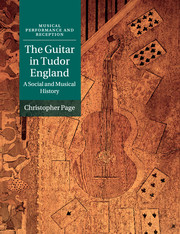Book contents
- Frontmatter
- Dedication
- Contents
- List of figures
- List of tables
- List of music examples
- Acknowledgments
- Note on music examples
- List of abbreviations
- Introduction
- 1 Imagery
- 2 Who owned a gittern?
- 3 The gittern trade
- 4 ‘An instruction to the Gitterne’
- 5 Sounding strings
- 6 The gittern and Tudor song
- 7 Thomas Whythorne: the autobiography of a Tudor guitarist
- Conclusion
- Appendix A The terms ‘gittern’ and ‘cittern’
- Appendix B References to gitterns from 1542 to 1605
- Appendix C The probate inventory of Dennys Bucke (1584)
- Appendix D Octave strings on the fourth and third course
- Appendix E The fiddle tunings of Jerome of Moravia, swept strings and the guitar
- Appendix F The mandore and the wire-strung gittern
- Appendix G The ethos of the guitar in sixteenth-century France
- Appendix H Raphe Bowle
- Bibliography
- Index
Introduction
Published online by Cambridge University Press: 05 June 2016
- Frontmatter
- Dedication
- Contents
- List of figures
- List of tables
- List of music examples
- Acknowledgments
- Note on music examples
- List of abbreviations
- Introduction
- 1 Imagery
- 2 Who owned a gittern?
- 3 The gittern trade
- 4 ‘An instruction to the Gitterne’
- 5 Sounding strings
- 6 The gittern and Tudor song
- 7 Thomas Whythorne: the autobiography of a Tudor guitarist
- Conclusion
- Appendix A The terms ‘gittern’ and ‘cittern’
- Appendix B References to gitterns from 1542 to 1605
- Appendix C The probate inventory of Dennys Bucke (1584)
- Appendix D Octave strings on the fourth and third course
- Appendix E The fiddle tunings of Jerome of Moravia, swept strings and the guitar
- Appendix F The mandore and the wire-strung gittern
- Appendix G The ethos of the guitar in sixteenth-century France
- Appendix H Raphe Bowle
- Bibliography
- Index
Summary
‘Keep close your friend's letters, for craft and malice never reigned more’. This is the warning that one friend gave to another in 1587, but it would have been good advice at any time in the sixteenth century. Those who sent letters on personal or political business under the Tudors had every reason to fear the ‘craft and malice’ of spies, and some resorted to ciphers and secret tokens. One such was Edward Courtenay, First Earl of Devon. In the winter of 1553–4, when he was widely believed to be the best match for Princess Elizabeth, Courtenay found himself ‘the rallying point for every major conspiracy’ against her half-sister, Queen Mary. To communicate with his allies, Courtenay hit upon a device that was unusually ingenious even by the standards of Elizabethan duplicity. He took a guiterre and marked it with a cipher known to his principal associate, Peter Carew. The deceit was soon discovered, however, and became common knowledge at court. The news reached two imperial ambassadors who reported it to their master, Charles V, a ruler with a deep political interest in the fortunes of the restored Catholic monarchy in England. The ambassadors assured the Emperor that Queen Mary and her Privy Council, having interrogated various suspects, now believed
that it was certain the guilt of the said Courtenay was established by several other prisoners, that he was a knowing and consenting participant in the said sworn agreement, [and that] he had a cipher inscribed on a guiterre for use with Peter Carew …
These details ring true, for both of the suspects were musicians. Edward Courtenay was remembered after his death as a talented performer on the lute, and Peter Carew made music with Henry VIII. What is more, the practice of inscribing a guitar with a symbol or ziffre of purely personal (as opposed to treasonable) significance was not unusual in the sixteenth century; a poem by Pierre de Ronsard celebrates a guiterre marked with his lady's name and his own en chifre. In this respect, as perhaps in others, Edward Courtenay and Peter Carew were guilty as charged.
- Type
- Chapter
- Information
- The Guitar in Tudor EnglandA Social and Musical History, pp. 1 - 10Publisher: Cambridge University PressPrint publication year: 2015



